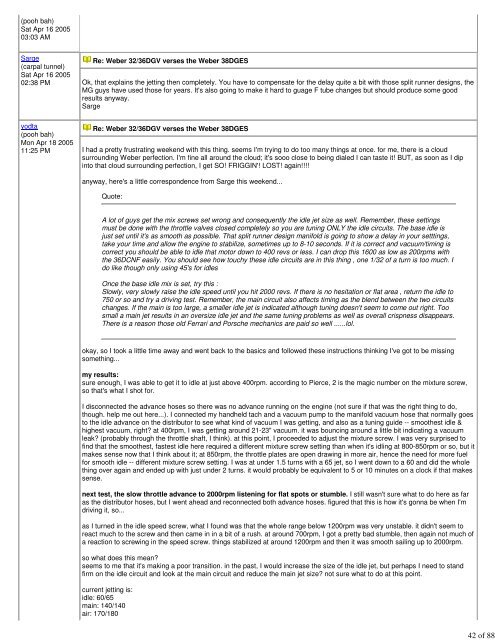You also want an ePaper? Increase the reach of your titles
YUMPU automatically turns print PDFs into web optimized ePapers that Google loves.
(pooh bah)<br />
Sat Apr 16 2005<br />
03:03 AM<br />
Sarge<br />
(carpal tunnel)<br />
Sat Apr 16 2005<br />
02:38 PM<br />
yodta<br />
(pooh bah)<br />
Mon Apr 18 2005<br />
11:25 PM<br />
Re: <strong>Weber</strong> <strong>32</strong>/<strong>36DGV</strong> <strong>verses</strong> <strong>the</strong> <strong>Weber</strong> <strong>38DGES</strong><br />
Ok, that explains <strong>the</strong> jetting <strong>the</strong>n completely. You have to compensate for <strong>the</strong> delay quite a bit with those split runner designs, <strong>the</strong><br />
MG guys have used those for years. It's also going to make it hard to guage F tube changes but should produce some good<br />
results anyway.<br />
Sarge<br />
Re: <strong>Weber</strong> <strong>32</strong>/<strong>36DGV</strong> <strong>verses</strong> <strong>the</strong> <strong>Weber</strong> <strong>38DGES</strong><br />
I had a pretty frustrating weekend with this thing. seems I'm trying to do too many things at once. for me, <strong>the</strong>re is a cloud<br />
surrounding <strong>Weber</strong> perfection. I'm fine all around <strong>the</strong> cloud; it's sooo close to being dialed I can taste it! BUT, as soon as I dip<br />
into that cloud surrounding perfection, I get SO! FRIGGIN'! LOST! again!!!!<br />
anyway, here's a little correspondence from Sarge this weekend...<br />
Quote:<br />
A lot of guys get <strong>the</strong> mix screws set wrong and consequently <strong>the</strong> idle jet size as well. Remember, <strong>the</strong>se settings<br />
must be done with <strong>the</strong> throttle valves closed completely so you are tuning ONLY <strong>the</strong> idle circuits. The base idle is<br />
just set until it's as smooth as possible. That split runner design manifold is going to show a delay in your setttings,<br />
take your time and allow <strong>the</strong> engine to stabilize, sometimes up to 8-10 seconds. If it is correct and vacuum/timing is<br />
correct you should be able to idle that motor down to 400 revs or less. I can drop this 1600 as low as 200rpms with<br />
<strong>the</strong> 36DCNF easily. You should see how touchy <strong>the</strong>se idle circuits are in this thing , one 1/<strong>32</strong> of a turn is too much. I<br />
do like though only using 45's for idles<br />
Once <strong>the</strong> base idle mix is set, try this :<br />
Slowly, very slowly raise <strong>the</strong> idle speed until you hit 2000 revs. If <strong>the</strong>re is no hesitation or flat area , return <strong>the</strong> idle to<br />
750 or so and try a driving test. Remember, <strong>the</strong> main circuit also affects timing as <strong>the</strong> blend between <strong>the</strong> two circuits<br />
changes. If <strong>the</strong> main is too large, a smaller idle jet is indicated although tuning doesn't seem to come out right. Too<br />
small a main jet results in an oversize idle jet and <strong>the</strong> same tuning problems as well as overall crispness disappears.<br />
There is a reason those old Ferrari and Porsche mechanics are paid so well ......lol.<br />
okay, so I took a little time away and went back to <strong>the</strong> basics and followed <strong>the</strong>se instructions thinking I've got to be missing<br />
something...<br />
my results:<br />
sure enough, I was able to get it to idle at just above 400rpm. according to Pierce, 2 is <strong>the</strong> magic number on <strong>the</strong> mixture screw,<br />
so that's what I shot for.<br />
I disconnected <strong>the</strong> advance hoses so <strong>the</strong>re was no advance running on <strong>the</strong> engine (not sure if that was <strong>the</strong> right thing to do,<br />
though. help me out here...). I connected my handheld tach and a vacuum pump to <strong>the</strong> manifold vacuum hose that normally goes<br />
to <strong>the</strong> idle advance on <strong>the</strong> distributor to see what kind of vacuum I was getting, and also as a tuning guide -- smoo<strong>the</strong>st idle &<br />
highest vacuum, right? at 400rpm, I was getting around 21-23" vacuum. it was bouncing around a little bit indicating a vacuum<br />
leak? (probably through <strong>the</strong> throttle shaft, I think). at this point, I proceeded to adjust <strong>the</strong> mixture screw. I was very surprised to<br />
find that <strong>the</strong> smoo<strong>the</strong>st, fastest idle here required a different mixture screw setting than when it's idling at 800-850rpm or so, but it<br />
makes sense now that I think about it; at 850rpm, <strong>the</strong> throttle plates are open drawing in more air, hence <strong>the</strong> need for more fuel<br />
for smooth idle -- different mixture screw setting. I was at under 1.5 turns with a 65 jet, so I went down to a 60 and did <strong>the</strong> whole<br />
thing over again and ended up with just under 2 turns. it would probably be equivalent to 5 or 10 minutes on a clock if that makes<br />
sense.<br />
next test, <strong>the</strong> slow throttle advance to 2000rpm listening for flat spots or stumble. I still wasn't sure what to do here as far<br />
as <strong>the</strong> distributor hoses, but I went ahead and reconnected both advance hoses. figured that this is how it's gonna be when I'm<br />
driving it, so...<br />
as I turned in <strong>the</strong> idle speed screw, what I found was that <strong>the</strong> whole range below 1200rpm was very unstable. it didn't seem to<br />
react much to <strong>the</strong> screw and <strong>the</strong>n came in in a bit of a rush. at around 700rpm, I got a pretty bad stumble, <strong>the</strong>n again not much of<br />
a reaction to screwing in <strong>the</strong> speed screw. things stabilized at around 1200rpm and <strong>the</strong>n it was smooth sailing up to 2000rpm.<br />
so what does this mean?<br />
seems to me that it's making a poor transition. in <strong>the</strong> past, I would increase <strong>the</strong> size of <strong>the</strong> idle jet, but perhaps I need to stand<br />
firm on <strong>the</strong> idle circuit and look at <strong>the</strong> main circuit and reduce <strong>the</strong> main jet size? not sure what to do at this point.<br />
current jetting is:<br />
idle: 60/65<br />
main: 140/140<br />
air: 170/180<br />
42 of 88


